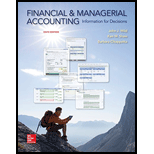
Concept explainers
Profit Margin Ratio:
Profit margin ratio represents the profitability of the given product. The formula to calculate profit margin ratio is,
Debt Ratio:
Debt ratio represents the capability of the company to pay its liabilities utilizing its assets. The formula to calculate debt ratio is,
Gross Margin Ratio:
Gross margin ratio measures the degree of profit earned by company by selling its inventory. The formula to calculate gross margin ratio is,
Acid Test Ratio:
Acid test ratio represents the capability of the company to pay its current liabilities by utilizing its quick assets, that is assets which be turned into cash within 90 days. The formula to calculate quick acid ratio is,
The formula to calculate quick assets is,
Accounts receivable turnover measures how frequently company recovers its receivables. The formula to calculate accounts receivable turnover is,
Basic Earnings per Share:
Basic earnings per share are a share of profit allocated to every outstanding share of stock. The formula to calculate basic earnings per share is,
Inventory Turnover Ratio:
Inventory turnover ratio is a tool to evaluate the number of times a company sells and change its inventory and how effectively company satisfies its orders. The formula to calculate inventory turnover is,
Dividend Yield:
Dividend yield is the dividend paid on share in comparison to its price. The formula to calculate dividend yield is,
To identify: Change in ratio to be classified under favorable and unfavorable.
Want to see the full answer?
Check out a sample textbook solution
Chapter 13 Solutions
Financial and Managerial Accounting: Information for Decisions
- Theron Interiors manufactures handcrafted cabinetry and uses a process costing system. During the month of October, the company started Production on 720 units and completed 590 units. The remaining 120 units were 60% complete in terms of materials and 40% complete in terms of labor and overhead. The total cost incurred during the month was $45,000 for materials and $31,200 for labor and overhead. Using the weighted-average method, what is the equivalent unit cost for materials and conversion costs (labor and overhead)?arrow_forwardGeneral Accountingarrow_forwardKamala Khan has to decide between the following two options: Take out a student loan of $70,000 and study accounting full time for the next three years. The interest on the loan is 4% per year payable annually. The principle is to be paid in full after ten years. Study part time and work part time to earn $15,000 per year for the following six years. Once Kamala graduates, she estimates that she will earn $30,000 for the first three years and $40,000 the next four years. Kamala's banker says the market interest for a ten-year horizon is 6%. Required Calculate NPV of the ten-year cash flows of the two options. For simplification assume that all cash flows happen at year-end. Based on the NPV which of the two options is better for Kamala?arrow_forward
- General accounting question and correct solutionarrow_forwardCan you explain the correct methodology to solve this financial accounting problem?arrow_forwardKiran Manufacturing produces a product with a standard direct labor cost of 1.8 hours at $18.75 per hour. During August, 2,250 units were produced using 4,150 hours at $17.50 per hour. What is the labor quantity variance (labor efficiency variance)?arrow_forward

 AccountingAccountingISBN:9781337272094Author:WARREN, Carl S., Reeve, James M., Duchac, Jonathan E.Publisher:Cengage Learning,
AccountingAccountingISBN:9781337272094Author:WARREN, Carl S., Reeve, James M., Duchac, Jonathan E.Publisher:Cengage Learning, Accounting Information SystemsAccountingISBN:9781337619202Author:Hall, James A.Publisher:Cengage Learning,
Accounting Information SystemsAccountingISBN:9781337619202Author:Hall, James A.Publisher:Cengage Learning, Horngren's Cost Accounting: A Managerial Emphasis...AccountingISBN:9780134475585Author:Srikant M. Datar, Madhav V. RajanPublisher:PEARSON
Horngren's Cost Accounting: A Managerial Emphasis...AccountingISBN:9780134475585Author:Srikant M. Datar, Madhav V. RajanPublisher:PEARSON Intermediate AccountingAccountingISBN:9781259722660Author:J. David Spiceland, Mark W. Nelson, Wayne M ThomasPublisher:McGraw-Hill Education
Intermediate AccountingAccountingISBN:9781259722660Author:J. David Spiceland, Mark W. Nelson, Wayne M ThomasPublisher:McGraw-Hill Education Financial and Managerial AccountingAccountingISBN:9781259726705Author:John J Wild, Ken W. Shaw, Barbara Chiappetta Fundamental Accounting PrinciplesPublisher:McGraw-Hill Education
Financial and Managerial AccountingAccountingISBN:9781259726705Author:John J Wild, Ken W. Shaw, Barbara Chiappetta Fundamental Accounting PrinciplesPublisher:McGraw-Hill Education





